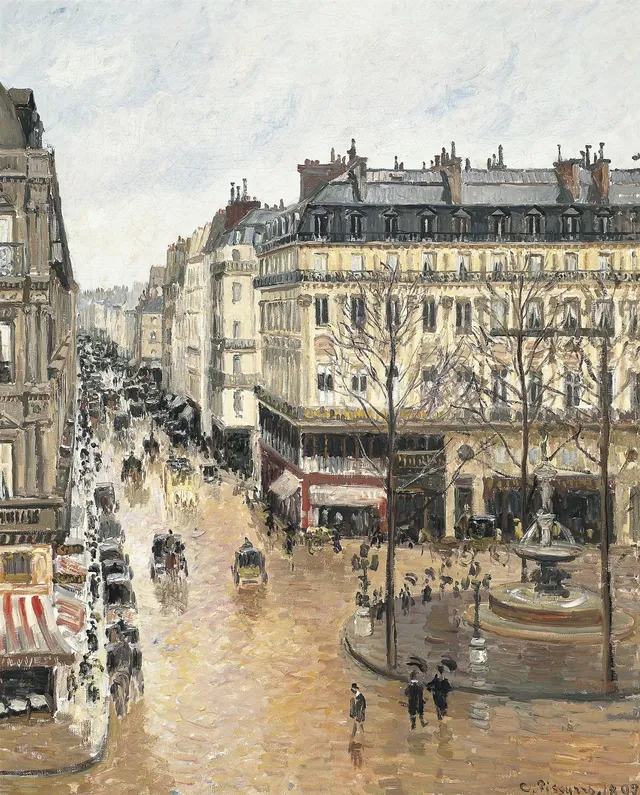News:
US court rules Nazi-looted Pissarro painting belongs to Spain
By Martha Lufkin
The decision by the Ninth Circuit Court of Appeals leaves the heirs of Lilly Cassirer with few options to pursue their restitution claim

Camille Pissarro, Rue St Honoré, apres-midi, effet de pluie (1897)
The double-decade dispute over a painting by Camille Pissarro that was stolen by the Nazis from a Jewish owner appears at an end with a decisive court ruling on 9 January, although the claimants say they will seek further court review. The opinion, by the Ninth Circuit Court of Appeals in California, addressed an issue of procedural law to produce the same conclusion on ownership it had reached before: that the Thyssen-Bornemisza Collection Foundation (TBC), in Madrid, owns Pissarro’s Rue Saint Honoré, apres midi, effet de pluie (1897).
The decision settles the question put to the Ninth Circuit by the US Supreme Court when it remanded the case in 2022: under California’s choice-of-law rues, which jurisdiction’s law applies to determine who owns the painting? Under California law, the plaintiffs would recover it; under Spain’s law, they would not. The court said that Spain’s law applied.
The opinion, by Judge Carlos T. Bea, focused on the “comparative impairment” analysis under California’s choice-of-law test, and concluded that under the facts of the case, Spain’s governmental interests—providing certainty of title to entities like TBC—would be more impaired if California’s law were applied than California’s interests—facilitating recovery for art theft victims and deterring theft—would be impaired if Spanish law applied. The court said that “the place in which the relevant conduct occurs” is “a crucial factor in measuring the jurisdictions’ relative interests”, and that California’s “sole contact to the dispute was the happenstance” that the plaintiff moved there in 1980. This made California’s interest in facilitating the plaintiff’s art recovery “minimal” as “none of the relevant conduct involving the painting occurred in California”.
Applying California’s law to this case “would leave entities in Spain, like TBC, unable to structure their conduct in Spain in reliance on Spain’s law”, the opinion said. In contrast, “the application of Spain’s laws would only relatively minimally impair California’s governmental interests”.
In 1939, Lilly Cassirer, the then Berlin-based owner, was forced to sell the painting to the Nazis, and was denied access to the sales proceeds. After several transactions, the painting moved to California in 1951, leaving there in 1952. In 1976, Baron Thyssen-Bornemysza bought it and kept it in Switzerland until 1992, when he loaned his collection including the painting to TBC, to be followed by Spain’s purchase of the collection in 1993. Since 1992, the painting has been on public display in Madrid at the Villahermosa Palace, which TBC, an instrumentality of Spain, maintains.
The plaintiffs are the heirs of the original plaintiff, Claude Cassirer, Lilly’s sole heir, who died in 2010.
Completing its review, the Ninth Circuit affirmed the lower court’s earlier judgment that TBC held prescriptive title to the painting, because under Spanish law it had possessed it publicly in good faith for over three years before the plaintiffs brought suit. In contrast, under California law, a thief cannot pass title to anyone, including a good faith buyer: TBC would not have title to the painting, and the plaintiffs would.
Lawyers for TBC, Thaddeus Stauber and Aaron Brian of the US law firm Nixon Peabody, and Javier Martínez Bavière of the Law Offices of Pedro Aleman, Madrid, tell The Art Newspaper in a joint statement that: “The Ninth Circuit’s unanimous affirmance of the trial court’s merits-based decision—confirming the Foundation’s ownership of the Pissarro painting that it lawfully acquired for public display in Madrid in 1993—is a welcome conclusion to this case.”
The Cassirers’ legal team tell The Art Newspaper in a statement that California’s laws “strongly support the rights of its residents to recover stolen works of art in the hands of museums. We believe the decision is incorrect in its application of California’s choice of law framework, and Mr. Cassirer will definitely seek en banc review” of the three-judge panel’s decision, meaning review by a larger panel of Ninth Circuit judges.
The court’s decision “fails to explain how Spain has any interest in applying its laws to launder ownership of the spoils of war”, the plaintiffs’ representatives add, nor “how a national museum owned by the Spanish government justifies holding onto a painting that it knows was looted by the Nazis from a Jewish family in the Holocaust.”


